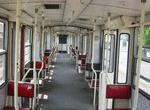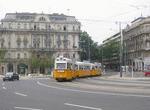Budapest, Hungary
![]()
BKV UV trams 3248 & 3327 at Deák Ferenc tér on route 49. Photo by Bernard Chatreau, July 2003.
Overview
Budapest, the capital city of Hungary, is home to a very large tramway system, which serves virtually every part of this exciting city.
The history of trams in Budapest began in 1866 with horse-drawn streetcars on Kálvin tér on the Pest side of the city (the cities Buda and Pest, on the west and east sides of the city, merged in 1873). The system was called BKVT, which is very close to today's BKV transit system.
Electric traction came to Budapest in 1887 in the form of a narrow gauge route on what is now today's Grand Boulevard, designed by Siemens and using an under-surface current collection system. The first standard-gauge electric railway opened two years later by the BVVV system. The two networks merged in 1923. (In addition, Budapest was home to Europe's first subway system, which opened in 1896.)
During World War II, the merged tramway system was decimated. The blowing up of all of the city's Danube River bridges by the retreating Germans was devastating. Nevertheless, the tramway system started anew in the postwar period and was rejuvenated, with hundreds of new trams built from 1956. The present-day BKV agency, which operates all trams, buses, trolleybuses and Metro routes, started up in 1968. Peak system size was reached around that time, but there has been retrenchment since, to the point that there are "only" 30 tram routes (down from 60). New Metro routes and expansion of buses helped put many tram routes and trams on the scrap pile.
Today's Budapest streetcar routes range from extremely heavy trunk lines such as the ones on the Grand Boulevard (running from Moszkva tér to the vicinity of Morisz Zsigmond körter) along the Pest side's busiest street, to routes serving sleepy rural areas and neighborhoods seemingly passed over by progress, as well as ones serving Buda's most exclusive neighborhoods. Tramways also operate along both banks of the Danube River. Ridership is very high, and crowded trams are the rule.
Budapest rosters four types of trams. The oldest in regular service are the UV 4-axle trams, made up into 2-car trains, or three-car sets with a trailer in the middle. These were built in several groups between 1956 and 1964. Trailers dating as far back as 1939 were rebuilt to match the style of the UV motors. About half of the fleet is still in service, and can be seen on Routes 19, 41, 42, 47, 49 and 52. They are numbered in the 3200, 3300, 3400 and 3800 series, with trailers numbered between 5808 and 6045. These bouncy, noisy trams are fun to ride! The UV type cars will be scrapped in 2005-2006, being replaced by Siemens "Combino" trams similar to those in Amsterdam. Three or four of the UV cars will be given to museums.
The next group of trams are the 1300/1400-series Ganz articulated streetcars (also called CSMG2 or ICS), which are very long. They arrived between 1967 and 1978, and serve lines 2, 4/6, 17, 24, 30/30A and 37/37A. On routes 4/6, they operate in 2-car trains. Some 30 of these were rebuilt starting in 1997 with chopper controls, fluorescent lighting and other improvements, and usually are assigned to Line 2.
Starting in 1979/80, and continuing through 1984, BKV purchased its first streetcars not made in Hungary: the Tatra T5C5 PCC cars. Numbered 4000-4171 and 4200-4349, these are Budapest's fastest trams. These 4-axle trams are set up in sets of two and three. Beginning in 2002, random numbers were selected to be rebuilt with chopper/thyristor controls, new interiors and the first dot-matrix route signs. The PCCs can be seen on lines 1, 12, 14, 18, 28 and 37. The rebuilt Tatras operate on 56, 59 and 61.
The newest group of Budapest trolleys are the ex-Hannover, Germany Duewag TW6000s, numbered in the 1500 series. 68 of these 1984-built streetcars arrived in 2001/2 and serve routes 3, 50, 62 and 69.
The numbers 3700-3799 were used for experimental and prototype cars, mostly in the 1950s but even today. 1987 experimental car #3750 is shown in the photo gallery.
Fares are about $1.00 per ride, and tickets are purchased at food outlets, tobacconists, and at hotels. They must be validated on board the tram, and are good for 1-1.5 hours. 1-day, 3-day and weekly passes are sold at most Metro stations.
Tram Photo Gallery
| Five Random Images | ||||
 Image 28104 (156k, 1152x864) Photo by: Bernard Chatreau Location: Pacsirtatelep |  Image 28145 (146k, 1152x864) Photo by: Bernard Chatreau Location: Szent Gellért tér |  Image 28161 (227k, 1152x768) Photo by: Bernard Chatreau Location: Astoria |  Image 28205 (200k, 1152x864) Photo by: Bernard Chatreau Location: Moszkva tér |  Image 28378 (62k, 740x498) Photo by: Peter Ehrlich Location: Fehérvari/Dombovári |
Metro Photo Gallery
| Five Random Images | ||||
 Image 5854 (110k, 1152x864) Photo by: Bernard Chatreau Location: Kõbánya - Kispest |  Image 6125 (191k, 1152x864) Photo by: Bernard Chatreau Location: Kõbánya - Kispest |  Image 6243 (130k, 1152x864) Photo by: Bernard Chatreau Location: Mexikói út |  Image 6302 (129k, 1152x864) Photo by: Bernard Chatreau Location: Mexikói út |  Image 7125 (157k, 1152x864) Photo by: Bernard Chatreau Location: Pillangó utca |
Page Credits
By Peter Ehrlich.